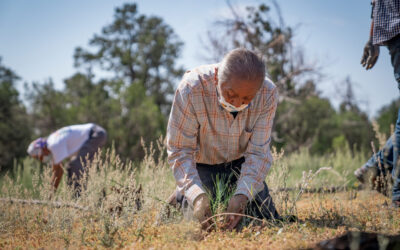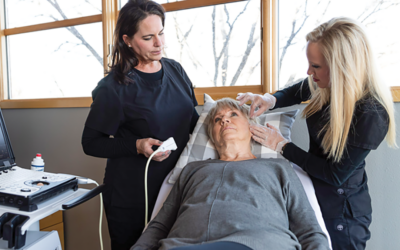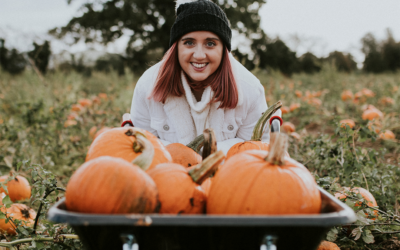Stuart Conway and Richard Fox founded Trees, Water & People (TWP) in 1998 to help reverse deforestation in Guatemala, Honduras, Nicaragua, El Salvador and other parts of Central America. Then it occurred to them that by planting trees without addressing the reasons they were being cut down, they were only doing half the job.
After looking at the bigger picture, the foresters learned that many trees were being used as firewood for cooking, which was depleting the landscape of its natural food sources, soil quality, shade and stability. They turned their attention to finding a more sustainable way to cook and ultimately landed on a simple clay stove design that was accessible and far more efficient.
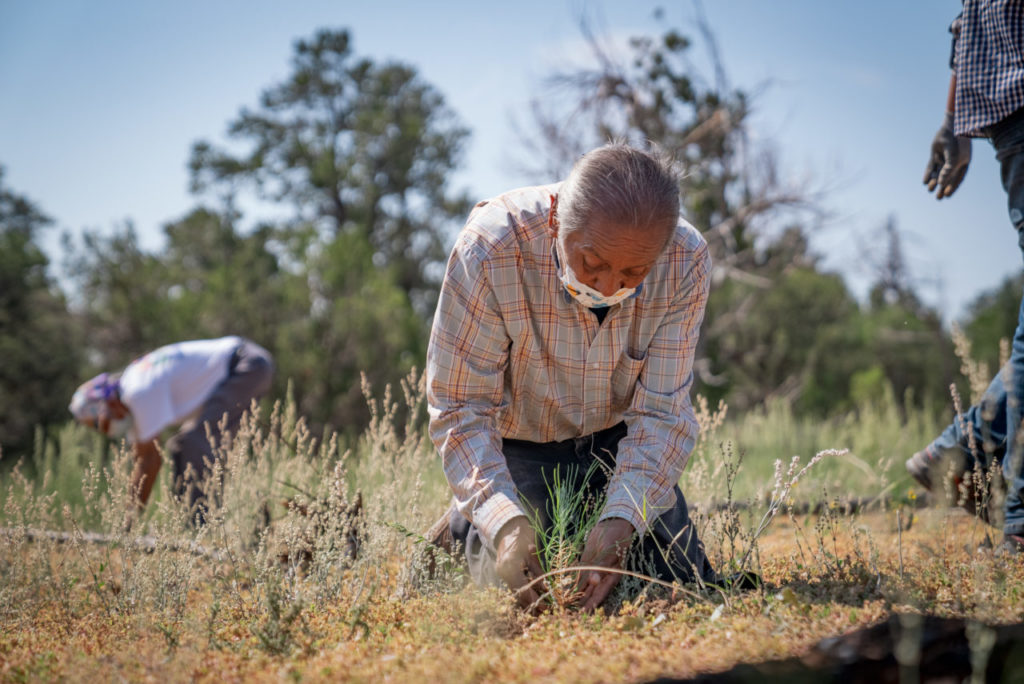
A Santo Domingo elder plants a Douglas Fir seedling on Kewa tribal lands.
“You can never ignore the human aspects of environmental work and the degradation that has on natural resources,” says Sebastian Africano, Executive Director of TWP. “A big part of the restoration process is helping these communities move away from unsustainable practices and use the land more to their advantage.”
The Fort Collins organization has since broadened its efforts to restore all aspects of the landscapes they focus their intention on instead of just setting up nurseries and planting trees. Reforestation still plays a big part, but the work now involves creating healthy watersheds, increasing food security and aiding in economic development. Africano says many Central American communities struggle with these issues, which are primary drivers of migration away from native lands.
The TWP team spends time in these communities and gets to know the locals long before they break ground on any particular project. Building trust and forming long-lasting relationships is the key to the organization’s success as it enables them to address the unique needs and priorities of each community.
“The clay stoves in particular serve as a model for how this type of work should be done because they are both technologically efficient and culturally appropriate,” says Paul Thayer, former Secretary on the TWP Board of Directors. “Genuine partnership and respect for different cultures is where you accomplish these kinds of goals.”
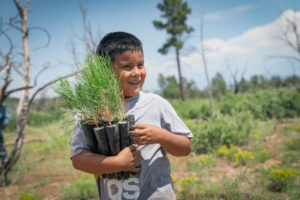
Christian Calabaza holding Douglas Fir seedlings.
After several years of working in Central America, Conway and Fox realized that indigenous people in the U.S. were facing similar issues. Many of them lived in remote communities with little access to public services or funding, and there were few economic opportunities and natural resources on their land. Wildfires were also becoming more frequent across the West, in some cases wiping out tribal lands and displacing entire communities.
TWP started forming relationships with the Cochiti Pueblo, Kewa Pueblo and Jemez Pueblo tribes in New Mexico, all of whom had lost a large percentage of their original forest to fires in the east Jemez Mountains. They also started working with tribes in Colorado and on Pine Ridge in South Dakota where wildfires had destroyed tribal lands.
There was a lot of work to be done in Pine Ridge, so Fox retired from TWP in 2017 and co-founded another nonprofit, Red Cloud Renewable, to lead reforestation and renewable energy initiatives in the area. He now serves as their grant writer and program strategist and works alongside TWP on many projects in South Dakota. Conway retired as International Director five years prior and has served on the TWP Board of Directors ever since.
From Pine Ridge to New Mexico, wildfires in the West often cross thousands of acres over multiple jurisdictions, making reforestation a challenge on indigenous lands. If the tribes no longer have jurisdictional control over their land, TWP helps to bridge the divide between native communities and state and federal agencies so that those communities have a say in how their cultural and archaeological sites are treated.
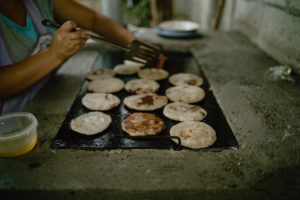
Tortillas cooked on a clean cookstove in El Salvador.
“Native populations often think on a timespan that’s inconceivable to most Western settlers because they’ve been on the land for thousands of years and have had just about every social and ecological challenge thrown at them,” Africano says. “They have a deep connection to the land and are thinking generations ahead to ensure that the resources are still there for their grandchildren. We have to look at the ecosystem as a whole and how it can support the community downstream.”
In 2020, TWP faced several new challenges: a global pandemic brought international travel to a halt, forcing the organization to pause work in Central America, and historic wildfires lit up Colorado. Forced to focus most of their efforts locally, the organization looked for ways to engage with the Central American, Mexican and Native American people in Northern Colorado. The result was a collaboration with Greeley artist Armando Silva on a 40-foot mural titled “Colores de la Comunidad.”
The mural, located in Tenney Alley in Old Town Fort Collins, illustrates the stories of migration shared by students and teachers in Poudre School District, as well as Native Americans in the community. Through conversations about movement of people, Silva was able to capture the pain and cultural detachment that comes with leaving home due to issues of safety, climate change or a lack of economic opportunity.
“It’s a story of two different worlds clashing together and coming together as one. We’re all in transition and reinventing the meaning of home throughout the migration process, whether that’s a foster home or a college dorm. There was a lot of reciprocity in that conversation because I was able to share my story, too,” Silva says.
“Colores de la Comunidad” was revealed to the community as smoke wafted in from the record-breaking wildfires that burned tens of thousands of acres of national forest two summers ago. Though 95 percent of the Cameron Peak Fire was on federal land and left tribes largely unaffected, TWP decided to do something about it.
TWP spent the last year-and-a-half working with local organizations like the Larimer County Conservation Corps, the Coalition for the Poudre River Watershed and the Big Thompson Watershed Coalition on reforestation efforts. Their crews planted more than 2,000 trees last spring with another 4,000 planned for this year.
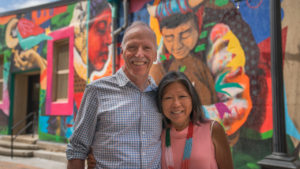
Paul and Marilyn Thayer, TWP board members at the “Colores de la Comunidad” mural in Old Town Fort Collins. Photos courtesy of TWP.
That figure is expected to exceed 20,000 trees in 2023 with the help of additional volunteers around Northern Colorado. Africano hopes the project will not only aid in the restoration efforts currently underway, but that it will also provide opportunities for native youth who are interested in biology, ecology, watershed science and natural resource restoration.
When international travel opened back up, TWP resumed work in Central America and revived its tour company, Travel With Purpose Tours, which had naturally evolved from trips TWP led with donors to see the impact of their funding. Now, anyone can embark on a trip with TWP Tours and get their hands dirty planting trees, building stoves and engaging with the locals.
“We travel with anyone who wants to see the real world behind the places where we work: groups of individuals, social organizations, businesses, students and other nonprofits,” Africano says. “They get to experience the things we’ve been working on for decades, and it’s a great opportunity for us to grow, to form new partnerships and to build a strong movement during what is going to be a difficult century, climate-wise.”



